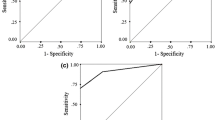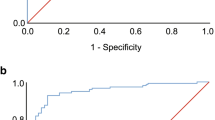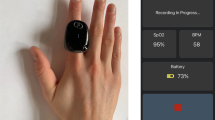Abstract
Objective
This study was designed to assess the sensitivity and specificity of a portable sleep apnea recording device (ApneaLink™) using standard polysomnography (PSG) as a reference and to evaluate the possibility of using the ApneaLink™ as a case selection technique for patients with suspected obstructive sleep apnea (OSA).
Materials and methods
Fifty patients (mean age 48.7 ± 12.6 years, 32 males) were recruited during a 4-week period. A simultaneous recording of both the standard in-laboratory PSG and an ambulatory level 4 sleep monitor (ApneaLink™) was performed during an overnight study for each patient. PSG sleep and respiratory events were scored manually according to standard criteria. ApneaLink™ data were analyzed either with the automated computerized algorithm provided by the manufacturer following the American Academy of Sleep Medicine standards (default setting DFAL) or The University of British Columbia Hospital sleep laboratory standards (alternative setting, ATAL). The ApneaLink respiratory disturbance indices (RDI), PSG apnea–hypopnea indices (AHI), and PSG oxygen desaturation index (ODI) were compared.
Results
The mean PSG-AHI was 30.0 ± 25.8 events per hour. The means of DFAL-RDI and ATAL-RDI were 23.8 ± 21.9 events per hour and 29.5 ± 22.2 events per hour, respectively. Intraclass correlation coefficients were 0.958 between PSG-AHI and DFAL-RDI and 0.966 between PSG-AHI and ATAL-RDI. Receiver operator characteristic curves were constructed using a variety of PSG-AHI cutoff values (5, 10, 15, 20, and 30 events per hour). Optimal combinations of sensitivity and specificity for the various cutoffs were 97.7/66.7, 95.0/90.0, 87.5/88.9, 88.0/88.0, and 88.2/93.9, respectively for the default setting. The ApneaLink™ demonstrated the best agreement with laboratory PSG data at cutoffs of AHI ≥ 10. There were no significant differences among PSG-AHI, DFAL-RDI, and ATAL-RDI when all subjects were considered as one group. ODI at 2%, 3%, and 4% desaturation levels showed significant differences (p < 0.05) compared with PSG-AHI, DFAL-RDI, and ATAL-RDI for the entire group.
Conclusion
The ApneaLink™ is an ambulatory sleep monitor that can detect OSA and/or hypopnea with acceptable reliability. The screening and diagnostic capability needs to be verified by further evaluation and manual scoring of the ApneaLink™. It could be a better choice than traditional oximetry in terms of recording respiratory events, although severity may be under- or overestimated.




Similar content being viewed by others
References
Duran-Cantolla J (2005) New directions in the diagnosis of sleep apnea-hypopnea syndrome. Arch Bronconeumol 41:645–648, doi:10.1016/S1579-2129(06)60330-3
Flemons WW, Douglas NJ, Kuna ST, Rodenstein DO, Wheatley J (2004) Access to diagnosis and treatment of patients with suspected sleep apnea. Am J Respir Crit Care Med 169:668–672, doi:10.1164/rccm.200308-1124PP
Young T, Evans L, Finn L, Palta M (1997) Estimation of the clinically diagnosed proportion of sleep apnea syndrome in middle-aged men and women. Sleep 20:705–706
Ghegan MD, Angelos PC, Stonebraker AC, Gillespie MB (2006) Laboratory versus portable sleep studies: a meta-analysis. Laryngoscope 116:859–864, doi:10.1097/01.mlg.0000214866.32050.2e
The Report of an American Academy of Sleep Medicine Task Force (1999) Sleep-related breathing disorders in adults: recommendations for syndrome definition and measurement techniques in clinical research. Sleep 22:667–689
Polysomnography Task Force, American Sleep Disorders Association Standards of Practice Committee (1997) Practice parameters for the indications for polysomnography and related procedures. Sleep 20:406–422
Flemons WW, Littner MR, Rowley JA, Gay P, Anderson WM, Hudgel DW et al (2003) Home diagnosis of sleep apnea: a systematic review of the literature. An evidence review cosponsored by the American Academy of Sleep Medicine, the American College of Chest Physicians, and the American Thoracic Society. Chest 124:1543–1579, doi:10.1378/chest.124.4.1543
Man GC, Kang BV (1995) Validation of a portable sleep apnea monitoring device. Chest 108:388–393, doi:10.1378/chest.108.2.388
Standards of Practice Committee of the American Sleep Disorders Association (1994) Practice parameters for the use of portable recording in the assessment of obstructive sleep apnea. Sleep 17:372–377
Chesson AL Jr, Berry RB, Pack A (2003) Practice parameters for the use of portable monitoring devices in the investigation of suspected obstructive sleep apnea in adults. Sleep 26:907–913
Collop NA, Anderson WM, Boehlecke B, Claman D, Goldberg R, Gottlieb DJ et al (2007) Clinical guidelines for the use of unattended portable monitors in the diagnosis of obstructive sleep apnea in adult patients. Portable Monitoring Task Force of the American Academy of Sleep Medicine. J Clin Sleep Med 3:737–747
de Almeida FR, Ayas NT, Otsuka R, Ueda H, Hamilton P, Ryan FC et al (2006) Nasal pressure recordings to detect obstructive sleep apnea. Sleep Breath 10:62–69, doi:10.1007/s11325-005-0042-x
Tanaka M, Katagai K, Tsutsumi Y, Namekawa T, Fukuhara T, Takizawa H et al (2002) An ambulatory respirometer (Hotmate) as a tool for screening of sleep apnea syndrome. Rinsho Byori 50:68–73
Penzel T, Kesper K, Ploch T, Becker HF, Vogelmeier C (2004) Ambulatory recording of sleep apnea using peripheral arterial tonometry. Conf Proc IEEE Eng Med Biol Soc 5:3856–3859
Pittman SD, Ayas NT, MacDonald MM, Malhotra A, Fogel RB, White DP (2004) Using a wrist-worn device based on peripheral arterial tonometry to diagnose obstructive sleep apnea: in-laboratory and ambulatory validation. Sleep 27:923–933
Zou D, Grote L, Peker Y, Lindblad U, Hedner J (2006) Validation a portable monitoring device for sleep apnea diagnosis in a population based cohort using synchronized home polysomnography. Sleep 29:367–374
Golpe R, Jimenez A, Carpizo R, Cifrian JM (1999) Utility of home oximetry as a screening test for patients with moderate to severe symptoms of obstructive sleep apnea. Sleep 22:932–937
Whitelaw WA, Brant RF, Flemons WW (2005) Clinical usefulness of home oximetry compared with polysomnography for assessment of sleep apnea. Am J Respir Crit Care Med 171:188–193, doi:10.1164/rccm.200310-1360OC
Lies A, Nabe B, Pankow W, Kohl FV, Lohmann FW (1996) Hypertension and obstructive sleep apnea. Ambulatory blood pressure monitoring before and with nCPAP-therapy. Z Kardiol 85(Suppl 3):140–142
Redline S, Budhiraja R, Kapur V, Marcus CL, Mateika JH, Mehra R et al (2007) The scoring of respiratory events in sleep: reliability and validity. J Clin Sleep Med 3:169–200
Netzer N, Eliasson AH, Netzer C, Kristo DA (2001) Overnight pulse oximetry for sleep-disordered breathing in adults: a review. Chest 120:625–633, doi:10.1378/chest.120.2.625
Nakano H, Ikeda T, Hayashi M, Ohshima E, Itoh M, Nishikata N et al (2004) Effect of body mass index on overnight oximetry for the diagnosis of sleep apnea. Respir Med 98:421–427, doi:10.1016/j.rmed.2003.11.009
Levendowski DJ, Morgan TD, Patrickus JE, Westbrook PR, Berka C, Zavora T et al (2007) In-home evaluation of efficacy and titration of a mandibular advancement device for obstructive sleep apnea. Sleep Breath 11:139–147, doi:10.1007/s11325-006-0094-6
Erman MK, Stewart D, Einhorn D, Gordon N, Casal E (2007) Validation of the ApneaLink™ for the screening of sleep apnea: a novel and simple single-channel recording device. J Clin Sleep Med 3:387–392
Wang Y, Teschler T, Weinreich G, Hess S, Wessendorf TE, Teschler H (2003) Validation of microMESAM as screening device for sleep disordered breathing. Pneumologie 57:734–740, doi:10.1055/s-2003-81/2423
Acknowledgments
The authors would like to thank Mrs. Ingrid Ellis for her editorial assistance in the final preparation of this manuscript and the polysomnographic technologists in UBC Hospital sleep disorder laboratory. As a postdoctoral fellow, Dr. Hui Chen was supported in part from royalties paid to The University of British Columbia from worldwide Klearway™ sales.
Author information
Authors and Affiliations
Corresponding author
Rights and permissions
About this article
Cite this article
Chen, H., Lowe, A.A., Bai, Y. et al. Evaluation of a portable recording device (ApneaLink™) for case selection of obstructive sleep apnea. Sleep Breath 13, 213–219 (2009). https://doi.org/10.1007/s11325-008-0232-4
Received:
Revised:
Accepted:
Published:
Issue Date:
DOI: https://doi.org/10.1007/s11325-008-0232-4




